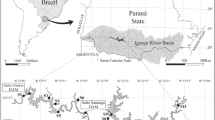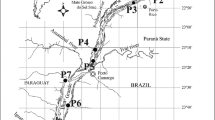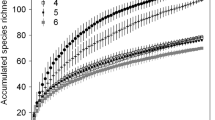Abstract
Simultaneous effects of productivity, environmental heterogeneity and spatial extent on beta diversity of microbial communities have seldom been investigated. Here, we evaluated how these components are related to diatom beta diversity in tropical reservoirs. We hypothesised positive relationships between diatom beta diversity and environmental heterogeneity, productivity and spatial extent. Regression models were used to model beta diversity as a function of different measures of abiotic environmental heterogeneity, productivity, reservoir morphology, spatial extent, and habitat heterogeneity. Our results suggest a strong relationship between beta diversity and environmental heterogeneity, productivity and spatial extent. However, contrary to our hypothesis, productivity was negatively related to beta diversity. We speculate that artificial eutrophication can lead to decreased beta diversity (biotic homogenisation). Furthermore, the relationship between beta diversity and abiotic environmental heterogeneity depends how this component was measured. In conclusion, environmental heterogeneity and dispersal limitation were likely the main factors that determined diatom beta diversity in tropical reservoirs.




Similar content being viewed by others
References
Anderson, M. J., 2006. Distance-based tests for homogeneity of multivariate dispersions. Biometrics 62: 245–253.
Anderson, M. J., K. E. Ellingsen & B. H. McArdle, 2006. Multivariate dispersion as a measure of beta diversity. Ecology Letters 9: 683–693.
Anderson, M. J., T. O. Crist, J. M. Chase, M. Vellend, B. D. Inouye, A. L. Freestone, N. J. Sanders, H. V. Cornell, L. S. Comita, K. F. Davies, S. P. Harrison, N. J. B. Kraft, J. C. Stegen & N. G. Swenson, 2011. Navigating the multiple meanings of b diversity: a roadmap for the practicing ecologist. Ecology Letters 14: 19–28.
APHA, 2005. Standard Methods for Examination of Water and Wastewater. American Public Health Association WWA, Washington, DC.
Astorga, A., R. Death, F. Death, R. Paavola, M. Chakraborty & T. Muotka, 2014. Habitat heterogeneity drives the geographical distribution of beta diversity: the case of New Zealand stream invertebrates. Ecology and Evolution 4: 2693–2702.
Battarbee, R. W., V. Jones, R. J. Flower, N. Cameron, H. Bennion, L. Carvalho & S. Juggins, 2001. Diatoms. In Smol, J. P., H. J. B. Birks & W. M. Last (eds), Tracking Environmental Change Using Lake Sediments. Kluwer Academic Publishers, London: 155–203.
Bicudo, D. C., P. I. Tremarim, P. D. A. Silva, S. Zorzal-Almeida, S. Wengrat, S. Faustino, L. F. Costa, E. C. R. Bartozek, A. R. Rocha, C. E. M. Bicudo & E. A. Morales, 2016. Ecology and distribution of Aulacoseira species (Bacillariophyta) from tropical reservoirs in Brazil. Diatom Research 31: 199–215.
Bini, L. M., V. L. Landeiro, A. A. Padial, T. Siqueira & J. Heino, 2014. Nutrient enrichment is related to two facets of beta diversity from stream invertebrates across the United States. Ecology 95: 1569–1578.
Bjornstad, O. N., 2016. Spatial nonparametric covariance functions. R package version 1.1-7. Available from URL: http://ento.psu.edu/directory/onb1.
Burnham, K. P. & D. R. Anderson, 2002. Model Selection and Multi-model Inference: A Practical Information – Theoretic Approach. Springer, New York.
Chase, J. M. & M. A. Leibold, 2002a. Spatial scale dictates the productivity-biodiversity relationship. Nature 416: 427–430.
Chase, J. M. & M. A. Leibold, 2002b. Ecological Niches: Linking Classical and Contemporary Approaches. The University of Chicago Press, Chicago.
Chase, J. M., 2010. Stochastic community assembly causes higher biodiversity in more productive environments. Science 328: 1388–1391.
Crump, B. C., H. E. Adams, J. E. Hobbie & G. W. Kling, 2007. Biogeography of bacterioplankton in lakes and streams of an arctic tundra catchment. Ecology 88: 1365–1378.
de Wit, R. & T. Bouvier, 2006. ‘Everithing is everywhere, but, the environment selects’; what did Bass Becking and Beijerinck really say? Environmental Microbiology 8: 755–758.
Dong, X., R. Muneepeerakul, J. D. Olden & D. A. Lytle, 2015. The effects of spatial configuration of habitat capacity on β diversity. Ecosphere 6: 1–11.
Donohue, I., A. L. Jackson, M. T. Pusch & K. Irvine, 2009. Nutrient enrichment homogenizes lake benthic assemblages at local and regional scales. Ecology 90: 3470–3477.
Dornelas, M., N. J. Gotelli, B. McGill, H. Shimadzu, F. Moyes, C. Sievers & A. E. Magurran, 2014. Assemblage time series reveal biodiversity change but not systematic loss. Science 344: 296–299.
Ellingsen, K. & J. S. Gray, 2002. Spatial patterns of benthic diversity: is there a latitudinal gradient along the Norwegian continental shelf? Journal of Animal Ecology 71: 373–389.
Finlay, B. J., 2002. Global dispersal of Free-living microbial eukaryote species. Science 296: 1061–1063.
Golterman, H. L., R. S. Clymo & M. A. M. Ohnstad, 1978. Methods for physical and chemical analisys of fresh waters. Blackwell Scientific Publications, Oxford.
Green, J. & B. J. M. Bohannan, 2006. Spatial scaling of microbial biodiversity. Trends in Ecology and Evolution 21: 501–507.
Halley, J. M., S. Hartley, A. S. Kallimanis, W. E. Kunin, J. J. Lennon & S. P. Sgardelis, 2004. Uses and abuses of fractal methodology in ecology. Ecology Letters 7: 254–271.
Hansson, L., C. Brönmark, P. A. Nilsson & K. Abjörnsson, 2005. Conflicting demands on wetlands ecosystem services: nutrient retention, biodiversity or both? Freshwater Biology 50: 705–714.
Harrison, S., K. F. Davies, H. D. Safford & J. H. Viers, 2006. Beta diversity and the scale-dependence of the productivity-diversity relationship: a test in the Californian serpentine flora. Journal of Ecology 94: 110–117.
Heino, J., A. S. Melo & L. M. Bini, 2015a. Reconceptualising beta diversity-environmental heterogeneity relationship in running water systems. Freshwater Biology 60: 223–235.
Heino, J., A. S. Melo, L. M. Bini, F. Altermatt, S. A. Al-Shami, D. G. Angeler, N. Bonada, C. Brand, M. Callisto, K. Cottenie, O. Dangles, D. Dudgeon, A. Encalada, E. Gothe, M. Gronroos, N. Hamada, D. Jacobsen, V. L. Landeiro, R. Ligeiro, R. T. Martins, M. L. Miserendino, C. S. M. Rawi, M. E. Rodrigues, F. O. Roque, L. Sandin, D. Schmera, L. F. Sgarbi, J. P. Simaika, T. Siqueira, R. M. Thompson & C. R. Townsend, 2015b. A comparative analysis reveals weak relationships between ecological factors and beta diversity of stream insect metacommunities at two spatial levels. Ecology and Evolution 5: 1235–1248.
Heino, J., L. M. Bini, S. M. Karjalainen, H. Mykrä, J. Soininen, L. C. G. Vieira & J. A. F. Diniz-Filho, 2010. Geographical patterns of micro-organismal community structure: are diatoms ubiquitously distributed across boreal streams? Oikos 119: 129–137.
Heino, J., M. Grönroos, J. Ilmonen, T. Karhu, M. Niva & L. Paasivirta, 2013. Environmental heterogeneity and β diversity of stream macroinvertebrate communities at intermediate spatial scales. Freshwater Science 32: 142–154.
Johnson, R. K. & G. A. Angeler, 2014. Effects of agricultural land use on stream assemblages: taxon-specific responses of alpha and beta diversity. Ecological Indicators 45: 386–393.
Kadowaki, K. & B. D. Inouye, 2015. Habitat configuration affects spatial pattern of β diversity of insect communities breeding in oyster mushrooooms. Ecosphere 6: 1–12.
Kalff, J., 2001. Limnology: Inland Water Ecosystems. Prentice-Hall, Upper Saddle River.
Kimmel, B. L., O. T. Lind & L. J. Paulson, 1990. Reservoir primary production. In Thornton, K. W., B. L. Kimmel & F. E. Payne (eds), Reservoir Limnology: Ecological Perspectives. Wiley, New York: 133–193.
Kovalenko, K. E., S. M. Thomaz & D. M. Warfe, 2012. Habitat complexity: approaches and future directions. Hydrobiologia 658: 1–17.
Langenheder, S., M. Berga, O. Östman & A. J. Székely, 2012. Temporal variation of b-diversity and assembly mechanisms in a bacterial metacommunity. The ISME Journal 6: 1107–1114.
Leibold, M. A., M. Holyoak, N. Mouquet, P. Amarasekare, J. M. Chase, M. F. Hoopes, R. D. Holt, J. B. Shurin, R. Law, D. Tilman, M. Loreau & A. Gonzalez, 2004. The metacommunity concept: a framework for multi-scale community ecology. Ecological Letters 7: 601–613.
Lindström, E. S., M. P. K. Agterveld & G. Zwart, 2005. Distribution of typical freshwater bacterial groups is associated with pH, temperature, and lake water retention time. Applied and Environmental Microbiology 71: 8201–8206.
Lopes, P. M., L. M. Bini, S. A. J. Declerck, V. F. Farjalla, L. C. G. Vieira, C. C. Bonecker, F. A. Lansac-Toha, F. A. Esteves & R. L. Bozelli, 2014. Correlates of zooplankton beta diversity in tropical lake systems. PLoS ONE 9: e109581.
López-Gonzáles, C., S. J. Presley, A. Lozano, R. D. Stevens & C. L. Higgins, 2014. Ecological biogeography of Mexican bats: the relative contributions of habitat heterogeneity, beta diversity, and environmental gradients to species richness and composition patterns. Ecography 37: 1–12.
Martin, B. & M. Ferrer, 2015. Temporally variable environments maintain more beta-diversity in Mediterranean landscapes. Acta Oecologica 68: 1–10.
Martiny, J. B. H., B. J. M. Bohannan, J. H. Brown, R. K. Colwell, J. A. Fuhrman, J. L. Green, M. C. Horner-Devine, M. Kane, J. A. Krumins, C. R. Kuske, P. J. Morin, S. Naeem, L. Øvreås, A. Reysenbach, V. H. Smith & J. T. Staley, 2006. Microbial biogeography: putting microorganisms on the map. Nature Reviews Microbiology 4: 102–112.
Martiny, J. B. H., J. A. Eisen, K. Penn, S. D. Allison & M. C. Horner-Devine, 2011. Drivers of bacterial β-diversity depend on spatial scale. Proceedings of the National Academy of Sciences 108: 7850–7854.
Mazerolle, M. J., 2016. Model selection and multimodel inference based on (Q)AIC(c). R package version 2.0–4. Available from URL: http://CRAN.Rproject.org/package=AICcmodavg.
McGoff, E., A. G. Solimini, M. T. Pusch, T. Jurca & L. Sandin, 2013. Does lake habitat alteration and land-use pressure homogenize European littoral macroinvertebrate communities? Journal of Applied Ecology 50: 1010–1018.
O’Malley, M. A., 2007. The nineteenth century roots of ‘everything is everywhere’. Nature Reviews Microbiology 5: 647–651.
Oksanen, J., F. G. Blanchet, R. Kindt, P. Legendre, P. R. Minchin, R. B. O’Hara, G. L. Simpson, P. Solymos, M. H. H. Stevens, E. Szoecs & H. Wagner, 2013. Vegan: Community Ecology Package. R package version 2.0–9. Available from URL: http://CRAN.Rproject.org/package=vegan.
Olden, J. D., 2003. A species specific approach to modeling biological communities and its potential for conservation. Conservation Biology 17: 854–863.
Pappas, J. L. & E. F. Stoermer, 1996. Quantitative method for determining a representative algal sample count. Journal of Phycology 32: 393–696.
Pinheiro, J., D. Bates, S. DebRoy, D. Sarkar, S. Heisterkamp & B. van Willigen, 2016. Linear and nonlinear mixed effects models. R package version 3.1-127. Available from http://bugs.r-project.org.
Powell, J. R., S. Karunaratne, C. D. Campbell, H. Yao, L. Robinson & B. K. Singh, 2015. Deterministic processes vary during community assembly for ecologically dissimilar taxa. Nature Communications 6: 8444.
R Core Team, 2015. R: a language and environment for statistical computing. R Foundation for Statistical Computing, Vienna.
Rasband, W., 2008. ImageJ. U.S. National Institutes of Health, Bethesda, Maryland. http://rsb.info.nih.gov/ij/.
Rouquette, J. R., M. Dallimer, P. R. Armsworth, K. J. Gaston, L. Maltby & P. H. Warren, 2013. Species turnover and geographic distance in an urban river network. Diversity and Distribution 19: 1429–1439.
Santos, J. B. O., L. H. S. Silva, C. W. C. Branco & V. L. M. Huszar, 2016. The roles of environmental conditions and geographical distances on the species turnover of the whole phytoplankton and zooplankton communities and their subsets in tropical reservoirs. Hydrobiologia 764: 171–186.
Sartory, D. P. & J. E. Grobbelaar, 1984. Extraction of chlorophyll a from freshwater phytoplankton for spectrophotometric analysis. Hydrobiologia 114: 177–187.
Smol, J. P., 2008. Pollution of Lakes and Rivers: A Paleoenvironmental Perspective, 2nd ed. Blackwell Publishing, Oxford.
Socolar, J. B., J. J. Gilroy, W. E. Kunin & D. P. Edwards, 2016. How should beta-diversity inform biodiversity conservation? Trends in Ecology & Evolution 31: 67–80.
Soininen, J., 2014. A quantitative analysis of species sorting across organisms and ecosystems. Ecology 95: 3284–3292.
Stein, A. & H. Kreft, 2015. Terminology and quantification of environemntal heterogeneity in species-richness research. Biological Reviews 90: 815–836.
Stein, A., K. Gerstner & H. Kreft, 2014. Environmental heterogeneity as a universal driver of species richness across taxa, biomes and spatial scales. Ecology Letters 17: 866–880.
Straskraba, M., J. G. Tundisi, A. Duncan, 1993. Comparative Reservoir Limnology and Water Quality Management. Dordrecht: Kluwer Academic Publishers, 1993. 293p.
Sugihara, G. & R. May, 1990. Application of fractals in ecology. Trends in Ecology & Evolution 5: 79–86.
Telford, R. J., V. Vandvik & H. J. B. Birks, 2006. dispersal limitation matter for microbial morphospecies. Science 312: 1015.
Thomaz, S. M., D. C. Souza & L. M. Bini, 2003. Species richness and beta diversity of aquatic macrophytes in a large subtropical reservoir (Itaipu Reservoir, Brazil): the influence of limnology and morphometry. Hydrobiologia 505: 119–128.
Thompson, R. & C. Townsend, 2006. A truce with neutral theory: local deterministic factors, species traits and dispersal limitation together determine patterns of diversity in stream invertebrates. Journal of Animal Ecology 75: 476–484.
Tokeshi, M. & S. Arakaki, 2012. Habitat complexity in aquatic systems: fractals and beyond. Hydrobiologia 685: 27–47.
Veech, J. A. & T. O. Crist, 2007. Habitat and climate heterogeneity maintain beta-diversity of birds among landscapes within ecoregions. Global Ecology and Biogeography 16: 650–656.
Vellend, M., D. S. Srivastava, K. M. Anderson, C. D. Brown, J. E. Jankowski, E. J. Kleynhans, N. J. B. Kraft, A. D. Letaw, A. A. M. Macdonald, J. E. Maclean, I. H. Myers-Smith, A. R. Norris & X. Xue, 2014. Assessing the relative importance of neutral stochasticity in ecological communities. Oikos 123: 1420–1430.
Vilar, A. G., H. van Dam, E. E. van Loon, J. A. Vonk, H. G. van Der Geest & W. Admiraal, 2014. Eutrophication decrease distance decay of similarity in diatom communities. Freshwater Biology 559: 1522–1531.
Wang, X., H. Li, T. M. Bezemer & Z. Hao, 2016. Drivers of bacterial beta diversity in two temperate forests. Ecological Research 31: 57–64.
Wetzel, C. E., D. C. Bicudo, L. Ector, E. A. Lobo, J. Soininen, V. Landeiro & L. M. Bini, 2012. Distance decay of similarity in neotropical diatom communities. Plos ONE 7: 1–8.
Whittaker, R. H., 1972. Evolution and measurement of species diversity. Taxon 21: 213–251.
Zuur, A., E. N. Ieno, N. Walker, A. A. Saveliev & G. M. Smith, 2009. Mixed Effects Models and Extensions in Ecology with R. Springer-Verlag, New York.
Acknowledgements
This study was carried out within the framework of the AcquaSed project supported by funds from FAPESP (Fundação de Amparo à Pesquisa do Estado de São Paulo, AcquaSed Project, nº 2009/53898–9) and was undertaken as part of S.Z.’s Ph.D. thesis (FAPESP doctoral fellowship nº 2013/23703-7 to S.Z.) at the Institute of Botany (São Paulo, Brazil). Funds were also provided by CNPq (Conselho Nacional de Desenvolvimento Científico e Tecnológico, grant 310940/2013–3 and 304314/2014-5 to D.C.B. and L.M.B., respectively). We deeply appreciate the valuable assistance of personnel from the agency in charge of the public water supply in São Paulo - SABESP (Companhia de Saneamento do Estado de São Paulo) and MSc. William de Queiroz for the study area map.
Author information
Authors and Affiliations
Corresponding author
Additional information
Guest editors: Koen Martens, Sidinei M. Thomaz, Diego Fontaneto & Luigi Naselli-Flores / Emerging Trends in Aquatic Ecology II
Electronic supplementary material
Below is the link to the electronic supplementary material.
Rights and permissions
About this article
Cite this article
Zorzal-Almeida, S., Bini, L.M. & Bicudo, D.C. Beta diversity of diatoms is driven by environmental heterogeneity, spatial extent and productivity. Hydrobiologia 800, 7–16 (2017). https://doi.org/10.1007/s10750-017-3117-3
Received:
Revised:
Accepted:
Published:
Issue Date:
DOI: https://doi.org/10.1007/s10750-017-3117-3




